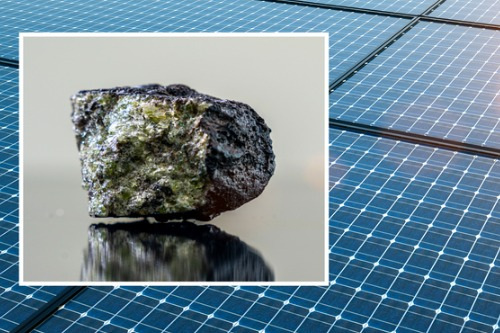HDI Global Insights: Breakthroughs in solar energy - Meet perovskite

Authored by HDI Global
Solar electricity generation grew by a record 20 per cent in 2020, which amounted to "almost double its previous highest annual increase”, according to the latest BP Statistical Review of World Energy. However, the report also revealed some sobering facts. Over the past five years, solar and wind combined still failed to make "even the smallest dent in total coal generation”.
To accelerate the transformation, scientists and entrepreneurs are challenging some of the most fundamental aspects of solar technology. A little-known mineral called perovskite may play a key role in increasing solar efficiency, driving down costs, and expanding our ability to use solar technology in completely new applications.
Silicon – the backbone of solar panels
Today, 95 per cent of all solar cells are made of silicon, a highly conductive material that is also widely used in computer processors. Silicon is one of the most abundant elements on Earth and therefore an inexpensive raw material. However, a large amount of energy is required to activate the conductive properties of silicon.
During the manufacturing process, silicon must be heated to temperatures of over 1,000 °C and undergo a multi-stage purification process. In addition, most industrially produced silicon cells do not exceed 20 per cent efficiency when converting sunlight into electricity.
These disadvantages have prompted research into alternatives to silicon that can provide the same conductivity without requiring as much energy during production. One such material is a crystalline compound called perovskite. Found abundantly within the earth's mantle, it may become an essential factor for the future of solar energy.
Perovskite – a game changer?
Perovskite solar cells (PSC) offer various advantages over conventional, silicon-based solar technology. For instance, the production process is considerably cheaper. According to Cambridge University physicist Sam Stranks,“the difference in expense is partly because making highly crystalline silicon requires heating it to a very high temperature to get rid of defects”, while PSCs "only need gentle heating to be defect-free, and they can be rolled out rapidly on big printers, which is more cost-effective.”
In addition, only a very thin layer of perovskite is needed in PSCs (perovskite solar cells), which lowers material costs. Solar cells made from perovskite can also be tuned to a variety of solar spectrum wavelengths, allowing them to generate more electricity from sunlight.
This flexibility allows perovskites to be combined with other materials, such as silicone (a polymer containing silicon), in a so-called tandem device architecture. Since perovskite can utilise some portions of the solar spectrum better than silicone-based solar panels, both materials in tandem can work more efficiently. Furthermore, PSCs can be made very thin and flexible, which means that they can work on glass and even as transparent foils, which in turn can be integrated into windows or car roofs.
…not without its limitations
Despite its attractiveness, perovskite has limitations. It is brittle and has a very short lifespan, deteriorating rapidly when exposed to natural elements such as wind and rain. Ten years ago, perovskite solar cells lasted only minutes. This destabilisation of the mineral's composite structure contributes to an even more insidious problem: the risk of lead leakage, one of the components of PSCs.
Scientists at the University of Nebraska-Lincoln set out to resolve the lead issue by initially experimenting with safer replacement materials. However, all such attempts proved unfruitful as they were unable to find a material that did not compromise the low-cost advantage of perovskites. After years of iteration, the researchers ultimately developed a method for containing the threat of lead leakage without sacrificing the cost-effectiveness of the perovskite platform. Still, lead remains one of the key components of perovskite solar cells.
Breakthroughs abound
Despite some of the challenges posed by PSCs, MIT researchers were able to achieve another breakthrough last year by increasing perovskite solar cell efficiency to an unprecedented 25.2 per cent. Just recently, a group of Swiss and French scientists broke yet another record by reaching 30.93 per cent efficiency in a lab environment with a tandem perovskite-silicone solar cell.
On top of these promising developments, a team of Princeton University researchers recently seems to have solved the problem of the short lifespan of PSCs. Led by Yueh-Lin Loo, professor of chemical and biological engineering, they developed a PSC that promises to yield "a commercially viable lifetime" which can perform above industry standards for around 30 years.
According to the scientists, PSCs will likely not completely replace silicon solar panels but "complement the old, making solar panels even cheaper, more efficient, and more durable than they are now, and expanding solar energy into untold new areas of modern life”.
Solving the recycling challenge
As promising as PSCs are, the recycling and reuse of perovskite-based solar cells is a crucial issue due to the contained lead. By 2030, about 8 million tons of decommissioned solar panels could pile up every year worldwide, reaching 80 million tons by 2050. The lack of systematic, large scale recycling programmes for critical materials used in solar panels means that considerable environmental challenges are looming in the near future.
Unfortunately, the traditional method of solar panel and rare metal recycling involves manually breaking down solar panels in search of the precious commodities. This low-tech solution has not only proven costly and time-consuming but also highly wasteful, as a considerable amount of the materials recovered in this way are not of sufficient quality to be reused in most manufacturing processes.
The inherent value of materials such as solar-grade silicone, silver, aluminium, and copper contained in solar installations can make recycling economically viable, however. The International Energy Agency (IEA) estimates that the value of recoverable raw materials from decommissioned solar panels will total $450 million by 2030.
Overall, the development seems very promising. While the technologies that harness the sun's energy keep increasing in efficiency and new materials expand the flexibility of solar panels, more sustainable alternatives need to be developed to ensure an environmentally sound life cycle. Perovskite is a great example of the potential that lies in even the most fundamental aspects of solar energy technology. With so many of the world's great minds committed to pushing the boundaries of solar technology and the recycling of old installations, it may not be long before new breakthroughs push solar into a new realm.
About HDI Global SE
Companies from the trading, production and service industries need an insurance partner they can rely on.
As part of the Talanx Group, HDI Global SE has been one of the leading insurers offering a broad and needs-based range of insurance solutions and accompanying services for decades.
HDI operates through foreign branches, subsidiaries and affiliates as well as network partners in more than 150 countries, offering international industrial insurance programmes.

